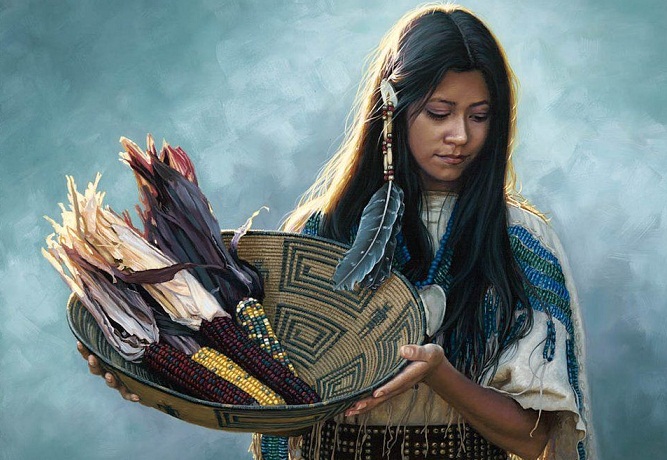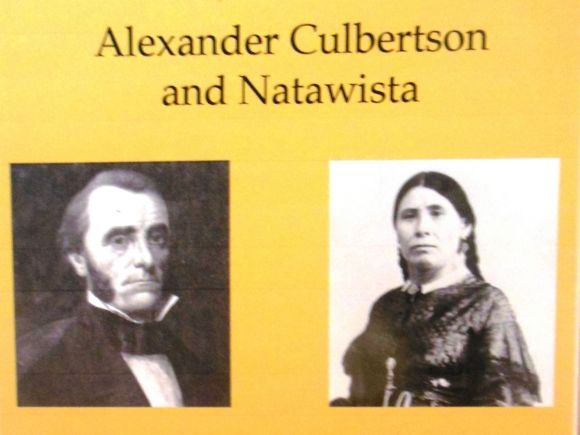
( – promoted by navajo)
American Indians were involved in trade for thousands of years prior to the arrival of the European and American fur traders. Traditional Indian trade was about relationships as much as it was about the material which was traded. In order to trade, a person needed to have trading partners, primarily relatives. An individual gained these trading partners through marriage and/or by being adopted into a family. The first fur traders quickly understood this and subsequently they usually married women from the tribes with whom they carried on trade.
In 1829, Fort Union, located on the boundary between Montana and North Dakota, was established as a trading post for the American Fur Company at the request of Iron Arrow Point, an Assiniboine chief. It soon became a trading center for many of the Northern Plains tribes, including the Blackfoot, Crow, Cree, Ojibwa, and Hidatsa. In order to strengthen their trade relations with these tribes, all of the traders took Indian wives, thus creating a web of alliances. This type of alliance was generally called a country marriage (le marriage á la façon du pays).
Alexander Culbertson, the American Fur Company trader, insisted that Fort Union was a stable outpost of civilization and therefore there had to be white linen on the table as well as milk and butter. Culbertson would sit at the head of the table and the visitors and clerks would be seated according to rank.
Natawista (also spelled Natoapxíxina, Na-ta-wis-ta-cha and Natoyist-Siksina), the daughter of Kaina (Blood) chief Man’stokos (Two Suns) and sister of the chief Seen Afar, was Culbertson’s second wife. Her name translates into English as Sacred Serpent or Medicine Snake. She was fifteen years old when she was brought to him in 1840 to be married. She arrived at Fort Union in a procession of Blood and Blackfoot warriors. It is unlikely that she had selected Culbertson as her husband: it was more likely that the chiefs and Culbertson saw this as an economic opportunity. Natawista helped her husband by cultivating friendly relationships between Indians and Americans and thus enhancing her husband’s profitable trade.
The Blood, whose homelands are in Alberta, Canada, are closely related to the Blackfoot and were often close allies.
In 1846, Culbertson established Fort Lewis (later renamed Fort Benton) at the confluence of the Marias and Missouri Rivers in Montana to accommodate the large number of buffalo robes offered by the Blackfoot. Natawista became invaluable to this trade by advising her husband.
While she did not speak English, she adopted American dress and manners. At the many balls held at the trading posts, Natawista was well-gowned in European fashion and performed as a model hostess. While there were times when her taste for raw liver and calf brains was disturbing to some guests, her beauty and social skills charmed nearly everyone. Among the notable visitors who met her were John J. Audubon, Swiss artist Rudolf Friedrich Kurz, Father Pierre DeSmet, Lewis Henry Morgan, and others.
In 1843, John J. Audubon described Natawista, whom he called Mrs. Culbertson, this way:
…the Ladies had their hair loose and flying in the breeze and then all mounted on horses with Indian saddles and trappings. Mrs. Culbertson and her maid rode astride like men, and all rode a furious race, under whip the whole way, for more than one mile on the prairie; and how amazed would have been any European lady, or some of our modern belles who boast their equestrian skill at seeing the magnificent riding of this Indian princess-for that is Mrs. Culbertson’s rank-and her servant.
Rudolf Friedrich Kurz described her as
One of the most beautiful Indian women…would be an excellent model for a Venus.
Natawista and Culbertson played important roles in the 1851 Fort Laramie Treaty Conference, in the 1853 Fort Benton Council, and in the 1855 Judith River Treaty Conference with the Blackfoot. While the Blackfoot were not present at the 1851 conference, Natawitsa and Culbertson helped the treaty council understand the extent of Blackfoot tribal territory. In 1854 she told the American treaty commissioners:
My people are a good people but they are jealous and vindictive. I am afraid that they and the whites will not understand each other, but if I go, I may be able to explain things to them and sooth them if they should be irritated. I know there is great danger.
Her daughters were taken from her by Culbertson and sent east so that they could be raised in American culture. We don’t know how Natawista felt about this, but there are some who feel that this created some tensions in the marriage.
When Culbertson retired from the fur trade, she went with him to live on a large estate near Peoria, Illinois. Here Natawista was baptized as Nelly and the couple was married by a Catholic priest in an ornate ceremony that hit the social column in the local newspaper. She enjoyed the fast horses and the private paddock of buffalo on the large estate. At one point she pitched a tipi on the front lawn of her magnificent mansion, much to the dismay of the neighbors.
The Civil War ruined Culbertson’s fortune and so they moved back to Fort Benton, Montana where they struggled to make ends meet. In 1870, the army attacked a peaceful Blackfoot camp in what came to be known as the Baker Massacre. Many Blackfoot fled to Canada for sanctuary. Natawista also fled north to her Blood people in Alberta. In 1877 she accepted treaty status as a Blood Indian in Canada. There she died in 1893 and was buried at the Catholic Church in Stand Off. Natawista Lake, also known as Janet Lake, in Glacier National Park is named for her.
Natawista’s story leaves us with many unanswered questions about Indian wives, country marriages, and the frontier. We don’t know to what extent she was a slave-wife or a concubine. We do know that she was an important part of her husband’s fur trading business, but she does not appear to be a true business partner, nor does the marriage appear to have been based on romance. Her story was a common one during the nineteenth century and most of the women involved have been forgotten by history, and in some cases, by their families.

The author asserts that Natawista has been forgotten by her family. We celebrate her and honor her life and strength. Our search for her burial ground is informed by this article. Yet, the author makes assertions that are contrary to our family’s memories and oral and written history of the Culbertsons and their half century of frontier diplomacy.
Great, great grand daughter and son of Natawista
Caroline Taylor
John Taylor